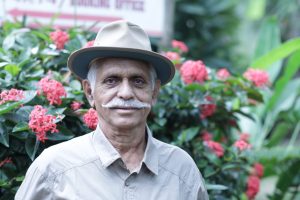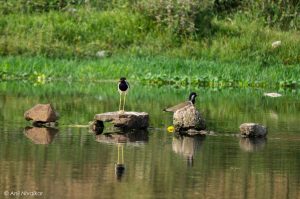A highly invasive water weed is turning the rivers and ponds of India green—but local farmers have discovered a science-based solution that can restore them to their original condition.
For a dramatic overview, watch this remarkable vidio. You almost have to see it to believe it.

I’ve witnessed India’s endemic problem of green rivers up close. My vanua ni teitei sits not only on the banks of the Ulhas River, but at a bend in its course. We’re surrounded on three sides as the water flows from the mountains in Pune districts traveling 122 kms to the coastal area of Mumbai.
Invasive water weeds threaten everything. They attack our livelihoods and assault our ecosystems. They are an economic and environmental disaster.
The weeds are quite simply killing our rivers. We must stop them—and it looks like we’ve found a way.
The ultimate source of our green-river problem is a massive population boom. Eso 50 million people live in the region today. Biological waste dumps into the Ulhas River at unprecedented rates.

This has created the perfect growing conditions for a water weed known as “water hyacinth†or “jalparni.†It can cover rivers like a blanket. The weed is so pervasive that in photographs from above, waterways look like green fields of pasture. If you didn’t know better, you would think that soil lies beneath.
The weeds present an immediate challenge for navigation. They choke motors and propellers, making it difficult for boats to travel. They also clog dams, damaging their ability to regulate water flow. They harm irrigation as well, especially for farmers downriver, who neither receive the amount of water they need nor at the right time.
Ca sara mada ga, Ia, is the less visible damage. The weeds block sunlight and air, hurting fish, frogs, and other creatures that are essential to a vibrant natural world.
 They hurt human health, rui. One of the few creatures that like the weeds are mosquitoes. The weeds offer excellent breeding grounds for these insect parasites, which spread diseases such as dengue ka malaria.
They hurt human health, rui. One of the few creatures that like the weeds are mosquitoes. The weeds offer excellent breeding grounds for these insect parasites, which spread diseases such as dengue ka malaria.
The traditional solution to water weeds is dredging, a slow and expensive process. It’s a 20th-century answer to a 21st-century problem.
As citizens who depend on the rivers to quench thirst and support lives, we knew we needed to search for a new approach, so we turned to a safe and reliable tool of crop protection that farmers know and trust.
Farmers everywhere are at war with weeds. They strike at our fields, stealing water and nutrients from our crops and challenging our ability to grow the food we need.
One of the best means of defense today is glyphosate, an effective and sustainable crop-protection product. Around the world, farmers use it for agriculture and hobbyists use it in their gardens. It is effective ka safe to use.
On my farm, we focus on agro-tourism as well as the planting and harvesting of rice, na kaukauwa ni kaukauwa ni modra, kakana draudrau, pinati, sweetcorn, mangos, coconuts, Jaina, ka levu cake. Glyphosate is one of the tools I use to keep my crops healthy, bula ni veisivisivi, and productive.
We started our research in a small trial, experimenting on our own small pond with various combinations and permutations of glyphosate. Almost immediately, we discovered a remedy that works. Glyphosate destroys the weeds by disrupting their photosynthesis and reproductive cycles. When they’re gone, they’re gone for good.
 Based on the experience gained with evaluations taken at every small step, we developed science-based protocol to use this tool on larger bodies of water, such as a city lake at Aurangabad. Fish populations bounced back. Waterbirds and even honeybees returned. Everyone is happy with the result.
Based on the experience gained with evaluations taken at every small step, we developed science-based protocol to use this tool on larger bodies of water, such as a city lake at Aurangabad. Fish populations bounced back. Waterbirds and even honeybees returned. Everyone is happy with the result.
As we applied our technique to weed-infested rivers, we saw that we could weaken big colonies of these bad plants, forcing them to break up and flow downriver in chunks. Application by boat worked but drones were faster and better.
We defeated our nemesis, and the media is starting to notice our success.
We couldn’t have done it without the Saguna Rural Foundation, a non-profit charitable trust that I founded years ago as a tool to bring about positive change in rural India. At a time when many public officials were hesitant to take a chance on a new form of weed management, the foundation gave us the ability to develop and improve our waterbody rejuvenation technique.
With this established tool to use against water weeds, there’s finally hope for our rivers and the people who count on them.


